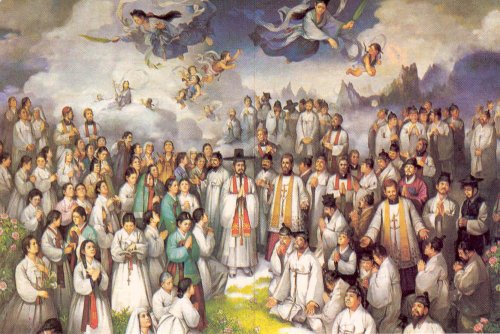Blessed Gaius, SJ
Born : 1552
Died : Nov 15, 1624
Beatified : May 7, 1867
 Gaius was a youth when his Korean parents offered him to a Buddhist monastery to begin life as a monk. He became dissatisfied with Buddhist teachings about God and left the community and went to live as a hermit in the mountains, far from the sea. As he lived in silence and prayer, he became convinced that there must be one Lord of all things, more powerful than the idols to which he had been praying. At twenty, he had a dream in which an aged man told him that during that same year he would cross the sea and after enduring many hardships all his desires would be fulfilled. He discounted the dream as he had neither the intention nor the desire to make a sea voyage.
Gaius was a youth when his Korean parents offered him to a Buddhist monastery to begin life as a monk. He became dissatisfied with Buddhist teachings about God and left the community and went to live as a hermit in the mountains, far from the sea. As he lived in silence and prayer, he became convinced that there must be one Lord of all things, more powerful than the idols to which he had been praying. At twenty, he had a dream in which an aged man told him that during that same year he would cross the sea and after enduring many hardships all his desires would be fulfilled. He discounted the dream as he had neither the intention nor the desire to make a sea voyage.
That year, 1592, Japan invaded Korea and many Koreans, including Gaius, were captured and handed over as slaves to Japanese lords. The ship carrying him was shipwrecked just as it was approaching the Japanese island of Tsushima but he and others survived and reached the shore. He was taken to Miyako (today’s Kyoto) and his master encouraged him to learn a trade but respecting his wishes arranged for him to join a monastery. However his second attempt to be a monk led to no more peace than his first attempt. He secretly attended catechism instructions at the Jesuit church and decided to be a Christian. With the head bonze’s permission, he departed the monastery.
Gaius was baptized in Miyako and asked to work with the missionaries and share their apostolic labours. The Jesuits accepted his offer as they were aware how valuable Gaius could be instructing the Koreans living in Japan after the war. Gaius soon became a catechist and worked in Osaka, then in Sakai and finally in Kanazawa. When Shogun Tokugawa Iyeyasu expelled foreign missionaries in 1614, Gaius attached himself as a servant to a former government official, Takayama Ukon who was in exile in Manila after he became a Christian. After Ukon’s death a year later Gaius was on his way back to Japan with two other Jesuits.
As a Korean, Gaius had no difficulty getting through the tight immigration controls at Nagasaki’s harbour. He soon took up lodging with another Korean Christian and made contact with the Jesuits and other priests in hiding and resumed missionary work of instructing people, baptizing children and converts, visiting the sick and those in prisons and burying the dead. He worked secretly amidst great personal danger for seven years until 1623, when he was arrested on a visit to a Spanish Franciscan priest in Nagasaki prison. The governor of the city offered Gaius his freedom if he would cease his apostolic labours but Gaius bravely answered that he feared neither prison, torture nor death itself. Thereupon the governor condemned him to be burned alive, but shortly afterwards changed his mind and sent him back to prison.
Gaius remained in prison for more than one and a half years. During this time he requested admission into the Society, saying that since “he was a son of the Society, he would so like to die in it.” His request was approved but before the good news could reach him, the governor signed his execution order and that same day Gaius was taken to Nagasaki’s Hill of Martyrs and there he embraced martyrdom by being burned alive.
Gaius, the first Korean to be admitted to the Society died a heroic death for the Lord who fulfilled all his desires and was beatified by Pope Pius XI on May 7, 1867.
